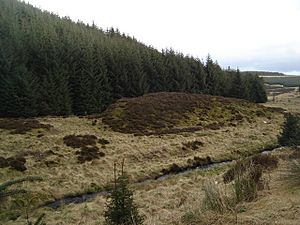Wormy Hillock Henge facts for kids
Quick facts for kids Wormy Hillock Henge |
|
|---|---|

A picture of the mound; the henge lies in the left half of the photo
|
|
| Location | Aberdeenshire, Scotland |
| Built | During the Neolithic Period |
| Architectural style(s) | British pre-Roman Architecture |
| Official name: Wormy Hillock | |
| Reference no. | 3278 |
| Lua error in Module:Location_map at line 420: attempt to index field 'wikibase' (a nil value). | |
Wormy Hillock Henge is a small, ancient circular monument in Aberdeenshire, Scotland. It is a special place called a Scheduled Ancient Monument. This means it is protected by law because it is very old and important. You can find it hidden in the Clashindarroch Forest.
This henge looks like a low, round bank of earth. It is about 16.5 meters (54 feet) across. Inside, there is a flat area in the middle. There is one opening in the bank, which is on the southeast side.
What is a Henge?
A henge is a type of ancient monument. It is usually a circular area of ground. This area is often surrounded by a ditch and a bank. Henges were built a very long time ago. They were made by people during the New Stone Age. Scientists are still learning why people built them. They might have been used for special ceremonies.
History of Wormy Hillock
People have known about Wormy Hillock Henge for a long time. In 1891, a man named James Macdonald explored the mound. He thought it might have been a place for sheep. He dug into it, but he did not find any old objects. This means the henge was likely not used for burying things.
The Dragon Legend
There is a cool old story about Wormy Hillock Henge. People say a dragon or monster was buried there. The legend tells that this dragon was attacking nearby villages. The brave villagers worked together and finally killed the monster.
They did not bury the whole dragon. Instead, they half-buried its body. Then, they piled dirt over it to make a big mound. This old story is how Wormy Hillock Henge got its name. The word "Wormy" used to mean "dragon" in old English.
Exploring the Site
Wormy Hillock Henge is in a beautiful spot. It sits in a deep valley within the Clashindarroch Forest. It is on a flat piece of land next to a river. The henge has a circular bank of earth. This bank is about 16.5 meters (54 feet) wide. It surrounds an oval area inside. This inner area is about 13.5 meters (44 feet) long. It is also about 13 meters (43 feet) wide.
The bank itself changes in size. It can be 3 meters (10 feet) wide and 10 centimeters (4 inches) high. In other places, it is 4 meters (13 feet) thick and 60 centimeters (2 feet) high. Wormy Hillock is called a 'mini-henge'. This is because it is smaller than 20 meters (66 feet) across.
Inside the bank, there is a small platform. It is about 6 meters (20 feet) wide. A ditch surrounds this platform. The ditch is about 1 meter (3 feet) deep. There are also some paths or causeways crossing the ditch. One of these paths lines up with the opening in the main bank. This opening is about 1 meter (3 feet) wide.
Scientists have found two small pits on the bank. These pits might be much newer than the henge itself. There is also a large rock in the ditch. It lies right below one of the pits. Today, the whole site is covered in grass and heather.

